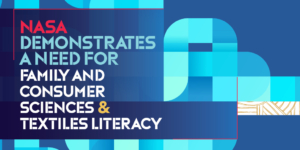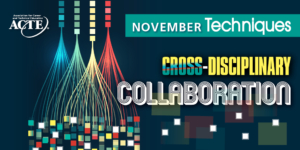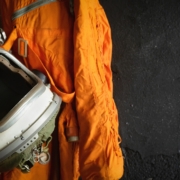NASA needs a sewing workforce
The world of textiles is complex and often misunderstood. Textiles cross industry sectors. They can be found everywhere from apparel and home furnishings to automotive garages and in space with the National Aeronautics and Space Administration — yes, NASA. In fact, the connections between textiles and space exploration are extensive.
NASA is a government agency responsible for science and technology related to air and space. This includes textile use in alternative living environments and the astronauts’ clothing while working in space. Recently, the technical knowledge and skills related to textiles gained the attention of Florence Gold, implementation project manager for NASA HUNCH. “There was always a need for sewn products from the very beginning of space flight,” she said. “From the time of the Apollo missions to the present, NASA has engaged people with meticulous sewing skills.”

The need for textile literacy
The most commonly recognized textiles are apparel. In 2017, in the U.S. alone, consumers spent more than $375 billion on apparel and footwear. But it is becoming more challenging for employers to find qualified sewing technicians.
There are four segments within the textiles industry.
- Raw production
- Design and development
- Manufacturing
- Promotion/sales
NASA’s need for a sewing workforce
When sending items to space, two considerations become extremely important. The first is the weight of the item and the second is the space the item will take up in a rocket. As NASA and commercial space industries go farther and farther into space, the cost to fly grows while the amount of cargo space decreases. This necessitates the use of softgoods, or sewn products.
In the beginning of space flight, the most commonly used materials were heavy, rigid metal. Now, cargo transfer bags made of flexible materials are better equipped to meet the needs of spaceflight. Sewing technicians have made spacesuits, parachutes, thermal blankets and many other sewn products for NASA. And now that the U.S. is planning to go back to the moon and then on to Mars, the list of sewn projects is expanding.
We cannot begin to imagine what the future might hold. NASA has a goal to live on the moon. Will habitats be built of layers of sewn products like our spacesuits? Will the lunar furniture be made from inflatable fabric? What about growing plants in pillows (Herridge, 2016)?
Softgoods developed by FCS students with NASA HUNCH
- Hygiene kits
- Cargo transfer bags
- Sleeping bag liners
- A modular shelving system and personal storage organizers
- A privacy curtain for hygiene activities
- Emergency bags for training and flight
- Stowage bags for dry trash disposal
- Desiccant bags to help control moisture on the ISS
- Trash containers to hold disposable bags of trash and help control odor
The need for family and consumer sciences education
Family and consumer sciences (FCS) educators teach life literacy skills. The discipline combines math, science, process management, materials management and efficiency in a hands-on setting. And these skills help lay a solid foundation for applying STEM concepts to everyday life.
“The connections [between FCS and aerospace] are extensive,” said Jennifer Leonard, NASA HUNCH softgoods program manager. “What has always been important for successful expeditions to new territories? The ability to make the trek and the ability to plan, manage resources, provide sustenance and shelter, and eventually establish civilizations. The ability to apply and incorporate these skills is life literacy.”
FCS educators have worked closely with HUNCH to assist NASA in its goal of scientific research and exploration. FCS students focus on foundational human problems, blending sciences. For example: Chemistry, botany and biology apply in the areas of food and nutrition, while sociology and psychology can help address family and societal needs. Most recently, FCS education in textiles and sewing has been identified as vitally important.
The need for cross-disciplinary collaboration
The future of space exploration depends on a workforce with the skills to think creatively — and to operate sewing machines in the production of softgoods for space. The HUNCH Sewn Flight Articles program challenges students to use fabric and other soft materials to create goods requested by different NASA centers as well as the International Space Station (ISS). This can range from redesigning the crew pantry to creating kits for the crew’s personal items.
Working with softgoods provides a unique design opportunity to help keep the crew not only safe but clean and comfortable aboard their stay at the ISS. These products range from new slippers that HUNCH students designed and had flown up to the ISS, to items that already exist, like the cargo transfer bags. And this diversity allows schools with different skill levels to participate so that no one is denied the chance to create.
The HUNCH mission is to empower and inspire students through project-based learning.
FCS students learn about quality assurance best practices so that they can maintain high product standards. They also learn proper safety documentation. And through the process, they learn to take responsibility for their output. Local teachers are trained to ensure HUNCH products meet the highest quality standards possible so that student work has the best chance of reaching the ISS.
Florence Gold, Ed.D., is the NASA HUNCH implementation project manager.
Gayla Randel, CFCS, is the FCS specialist at the Montana Office of Public Instruction and is part of the Northwest Regional Task Force for Apparel and Textiles.
Jennifer M. Leonard is the NASA HUNCH softgoods program manager.




